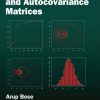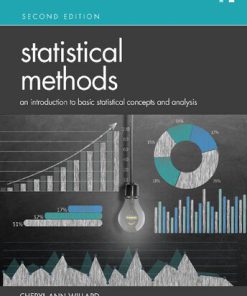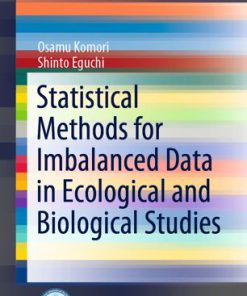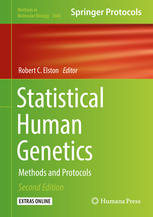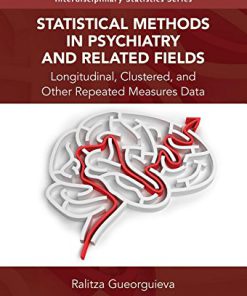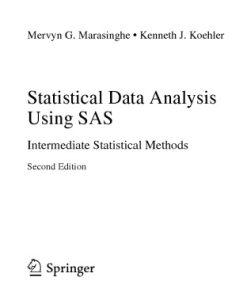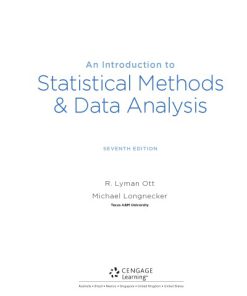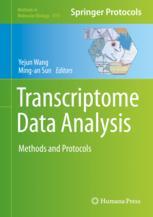Foundations and Methods in Combinatorial and Statistical Data Analysis and Clustering 1st Edition by Israel Cesar Lerman ISBN 1447167910 9781447167914
$50.00 Original price was: $50.00.$25.00Current price is: $25.00.
Foundations and Methods in Combinatorial and Statistical Data Analysis and Clustering 1st Edition by Israel César Lerman – Ebook PDF Instant Download/Delivery: 1447167910, 978-1447167914
Full dowload Foundations and Methods in Combinatorial and Statistical Data Analysis and Clustering 1st Edition after payment

Product details:
ISBN 10: 1447167910
ISBN 13: 978-1447167914
Author: Israel Cesar Lerman
This book offers an original and broad exploration of the fundamental methods in Clustering and Combinatorial Data Analysis, presenting new formulations and ideas within this very active field.
With extensive introductions, formal and mathematical developments and real case studies, this book provides readers with a deeper understanding of the mutual relationships between these methods, which are clearly expressed with respect to three facets: logical, combinatorial and statistical.
Using relational mathematical representation, all types of data structures can be handled in precise and unified ways which the author highlights in three stages:
- Clustering a set of descriptive attributes
- Clustering a set of objects or a set of object categories
- Establishing correspondence between these two dual clusterings
Tools for interpreting the reasons of a given cluster or clustering are also included.
Foundations and Methods in Combinatorial and Statistical Data Analysis and Clustering will be a valuable resource for students and researchers who are interested in the areas of Data Analysis, Clustering, Data Mining and Knowledge Discovery.
Foundations and Methods in Combinatorial and Statistical Data Analysis and Clustering 1st Table of contents:
Chapter 1: On Some Facets of the Partition Set of a Finite Set
- 1.1 Lattice of Partition Set of a Finite Set
- Definition and General Properties
- Countings
- 1.2 Partitions of an Integer
- Generalities
- Representations
- 1.3 Type of a Partition and Cardinality of the Associated Equivalence Binary Relation
- 1.4 Ultrametric Spaces and Partition Chain Representation
- Definition and Properties of Ultrametric Spaces
- Partition Lattice Chains of a Finite Set and the Associated Ultrametric Spaces
- Partition Lattice Chains and the Associated Ultrametric Preordonances
- Partition Hierarchies and Dendrograms
- From a Symmetrical Binary Hierarchy to a Directed Binary Hierarchy
- 1.5 Polyhedral Representation of the Partition Set of a Finite Set
Chapter 2: Two Methods of Non-hierarchical Clustering
- 2.1 Preamble
- 2.2 Central Partition Method
- Data Structure and Clustering Criterion
- Transfer Algorithm and Central Partition
- Objects with the Same Representation
- Statistical Asymptotic Analysis
- Remarks on the Application of the Central Partition Method and Developments
- 2.3 Dynamic and Adaptative Clustering Method
- Data Structure and Clustering Criterion
- The K-Means Algorithm
- Dynamic Cluster Algorithm
- Following the Definition of the Algorithm
Chapter 3: Structure and Mathematical Representation of Data
- 3.1 Objects, Categories and Attributes
- 3.2 Representation of the Attributes of Type I
- The Boolean Attribute
- The Numerical Attribute
- Defining a Categorical Attribute from a Numerical One
- 3.3 Representation of the Attributes of Type II
- The Nominal Categorical Attribute
- The Ordinal Categorical Attribute
- The Ranking Attribute
- The Categorical Attribute Valuated by a Numerical Similarity
- The Valuated Binary Relation Attribute
- 3.4 Representation of the Attributes of Type III
- The Preordonance Categorical Attribute
- The Taxonomic Categorical Attribute
- The Taxonomic Preordonance Attribute
- Coding the Different Attributes in Terms of Preordonance or Similarity Categorical Attributes
- 3.5 Attribute Representations When Describing a Set of Categories
- Introduction
- Attributes of Type I
- Nominal or Ordinal Categorical Attributes
- Ordinal (Preordonance) or Numerical Similarity Categorical Attributes
- The Data Table: A Tarski System or a Statistical System
Chapter 4: Ordinal and Metrical Analysis of the Resemblance Notion
- 4.1 Introduction
- 4.2 Formal Analysis in the Case of a Description of an Object Set
- Similarity Index in the Case of Boolean Data
- Preordonance Associated with a Similarity Index in the Case of Boolean Data
- 4.3 Extension of the Indices Defined in the Boolean Case to Attributes of Type II or III
- Comparing Nominal Categorical Attributes
- Comparing Ordinal Categorical Attributes
- Comparing Preordonance Categorical Attributes
Chapter 5: Comparing Attributes by Probabilistic and Statistical Association I
- 5.1 Introduction
- 5.2 Comparing Attributes of Type I for an Object Set Description
- The Boolean Case
- Comparing Numerical Attributes in the LLA Approach
- 5.3 Comparing Attributes for a Description of a Set of Categories
- Case of a Description by Boolean Attributes
- Comparing Distributions of Numerical, Ordinal Categorical, and Nominal Categorical Attributes
Chapter 6: Comparing Attributes by Probabilistic and Statistical Association II
- 6.1 Introduction
- 6.2 Comparing Attributes of Type II for an Object Set Description
- Introduction; Alternatives in Normalizing Association Coefficients
- Comparing Two Ranking Attributes
- Comparing Two Nominal Categorical Attributes
- Comparing Two Ordinal Categorical Attributes
- Comparing Two Valuated Binary Relation Attributes
- From the Total Association to the Partial One
Chapter 7: Comparing Objects or Categories Described by Attributes
- 7.1 Preamble
- 7.2 Comparing Objects or Categories by the LLA Method
- Similarity Index Between Objects Described by Numerical or Boolean Attributes
- Similarity Index Between Objects Described by Nominal or Ordinal Categorical Attributes
- Similarity Index Between Objects Described by Preordonance or Valuated Categorical Attributes
- Similarity Index Between Objects Described by Taxonomic Attributes
- Similarity Index Between Objects Described by a Mixed Attribute Types: Heterogenous Descriptions
- The Goodall Similarity Index
- Similarity Index Between Rows of a Juxtaposition of Contingency Tables
Chapter 8: The Notion of “Natural” Class, Tools for Its Interpretation, and the Classifiability Concept
- 8.1 Introduction: Monothetic Class and Polythetic Class
- The Intuitive Approaches of Beckner and Adanson
- 8.2 Discriminating a Cluster of Objects by a Descriptive Attribute
- Case of Attributes of Type I: Numerical and Boolean
- Discriminating a Partition by a Categorical Attribute
- 8.3 “Responsibility” Degree of an Object in an Attribute Cluster Formation
- The Attribute Set is Composed of Attributes of Type I
- The Attribute Set is Composed of Categorical or Ranking Attributes
- 8.4 Rows or Columns of Contingency Tables
- Case of a Single Contingency Table
- Case of a Horizontal Juxtaposition of Contingency Tables
- 8.5 Measuring the “Importance” of a Descriptive Attribute
- Comparing Clustering “Importance” and Projective “Importance” of a Descriptive Attribute
- 8.6 Crossing Fuzzy Categorical Attributes or Fuzzy Classifications (Clusterings)
- Crossing Net Classifications
- Crossing a Net and a Fuzzy Dichotomous Classification
- 8.7 Classifiability
- Discrepancy Between the Preordonance Structure and the Ultrametric Structure on a Data Set
- Classifiability Distribution Under a Random Hypothesis of Non-ultrametricity
Chapter 9: Quality Measures in Clustering
- 9.1 Introduction
- 9.2 The Direct Clustering Approach: An Example of a Criterion
- An Example of Quality Measurement
- 9.3 Quality of a Partition Based on Pairwise Similarities
- Approximating a Symmetrical Binary Relation by an Equivalence Relation: The Zahn Problem
- 9.4 Measuring the Fitting Quality of a Partition Chain (Classification Tree)
- Generalization of the Set Theoretic and Metrical Criteria
- Pure Ordinal Criteria: The Lateral Order and Lexicographic Order Criteria
Chapter 10: Building a Classification Tree
- 10.1 Introduction
- 10.2 “Lexicographic” Ordinal Algorithm
- Definition of an Ultrametric Preordonance Associated with a Preordonance Data
- Algorithm for Determining ωu Defined by the H Function
- 10.3 Ascendant Agglomerative Hierarchical Clustering Algorithm
- “Single Linkage”, “Complete Linkage” and “Average Linkage” Criteria
- “Inertia Variation” (Ward) Criterion
- 10.4 AAHC Algorithms; Likelihood Linkage Criteria
- Maximal Likelihood Linkage Family of Criteria
- 10.5 AAHC for Clustering Rows or Columns of a Contingency Table
- Chi Square Criterion
- Mutual Information Criterion
- 10.6 Efficient Algorithms in Ascendant Agglomerative Hierarchical Classification
- Complexity Considerations
- Reducibility and Monotonic Criterion
Chapter 11: Applying the LLA Method to Real Data
- 11.1 Introduction: CHAVL Software
- 11.2 Real Data Processing
- Types of Child Characters Through Children’s Literature
- Profiles Extracted from the Classification Tree
- 11.3 Dayhoff, Henikoff’s Matrices and LLA for Comparing Proteic Sequences
- 11.4 Clustering Categorical Attributes
- Structuring the Sets of Values
- Partial Association Between Categorical Attributes
Chapter 12: Conclusion and Thoughts for Future Works
- 12.1 Contribution to Challenges in Cluster Analysis
- 12.2 Developments in the Framework of the LLA Approach
- Principal Component Analysis
- Semi-supervised Hierarchical Classification
- 12.3 Future Directions in Big Data
People also search for Foundations and Methods in Combinatorial and Statistical Data Analysis and Clustering 1st:
foundations of combinatorics with applications
combinatorial analysis mit
differential forms and connections
ensemble methods foundations and algorithms pdf
You may also like…
Computers - Programming
Biology and other natural sciences - Ecology
Statistical Methods for Imbalanced Data in Ecological and Biological Studies Osamu Komori
Computers - Computer Science
Science (General)
Computers - Computer Science
Analysis for computer scientists foundations methods and algorithms Second Edition Oberguggenberger
Biology and other natural sciences - Molecular
Transcriptome Data Analysis Methods and Protocols 1st Edition Yejun Wang



